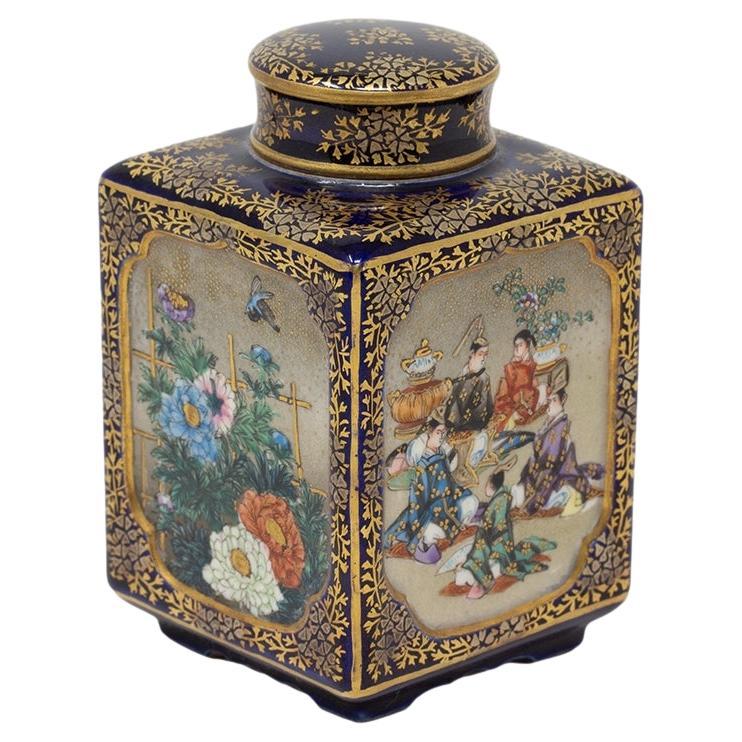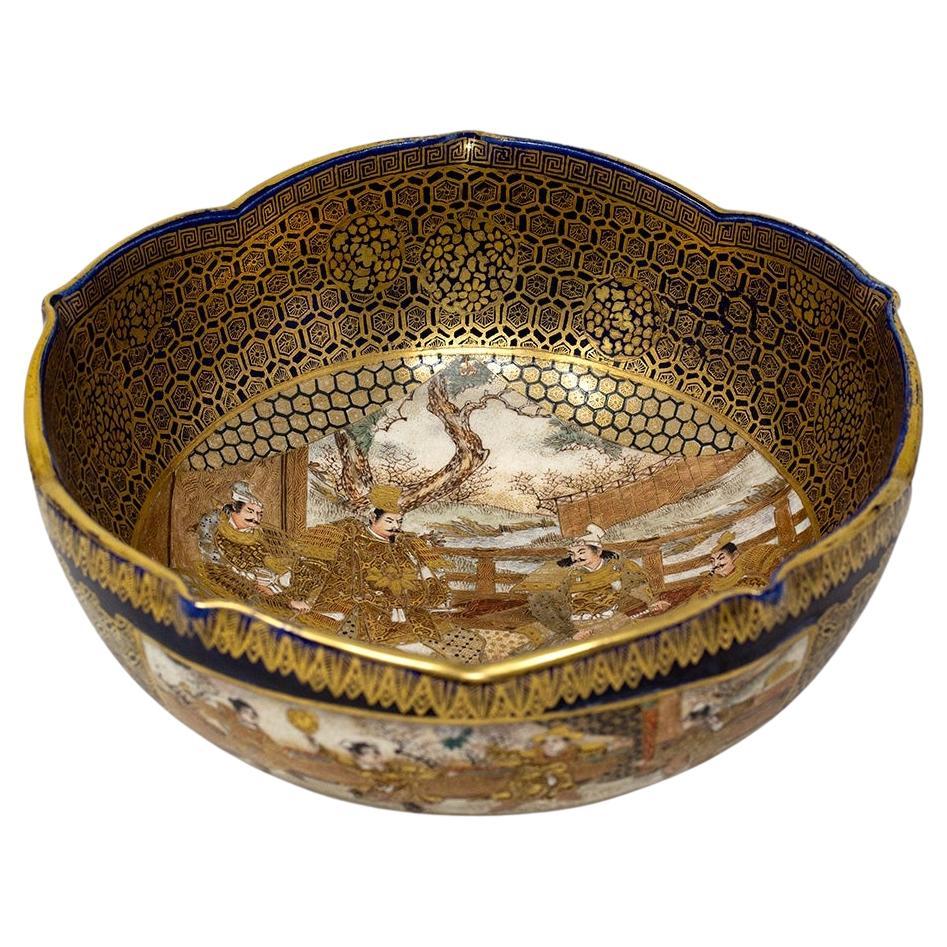Items Similar to Antique Early 1900s Japanese Kinkozan Satsuma Picture Frame Japan Flowers
Want more images or videos?
Request additional images or videos from the seller
1 of 12
Antique Early 1900s Japanese Kinkozan Satsuma Picture Frame Japan Flowers
About the Item
Description
A Japanese Satsuma photograph frame, Kinkozan, Meiji/Taisho period
Of gourd outline and painted with the 'three abundances' of peaches, pomegranate and finger citron with other fruits and flowers.
Satsuma picture frames are very rare!
Marked: Kinkozan
--------------------------------------------------------------------------------------------------------------------
Condition
Overall condition perfect. Size 150 x 124 x 20mm D x H
Period
Meiji Periode (1867-1912).
- Dimensions:Height: 5.91 in (15 cm)Width: 4.89 in (12.4 cm)Depth: 0.79 in (2 cm)
- Style:Meiji (Of the Period)
- Materials and Techniques:
- Place of Origin:
- Period:
- Date of Manufacture:1867-1912
- Condition:Overall Condition is perfect.
- Seller Location:Amsterdam, NL
- Reference Number:1stDibs: LU4863225076582
About the Seller
5.0
Gold Seller
These expertly vetted sellers are highly rated and consistently exceed customer expectations.
Established in 2015
1stDibs seller since 2019
158 sales on 1stDibs
Typical response time: 11 hours
- ShippingRetrieving quote...Ships From: Amsterdam, Netherlands
- Return PolicyA return for this item may be initiated within 14 days of delivery.
More From This SellerView All
- Antique 19C Japanese Satsuma High Quality Vase in Pipe Shape with FlowersLocated in Amsterdam, Noord HollandDescription A Faboulas Japanese Satsuma vase, Meiji period ----------------------------------------------------------------------------------------------------------------- Co...Category
Antique 19th Century Japanese Meiji Ceramics
MaterialsPorcelain
- Antique 19C Japanese Turqoise Satsuma Water Pot or Koro Marked BaseLocated in Amsterdam, Noord HollandA Japanese Satsuma water pot, Meiji period. With cranes and flowers. Marked on base. Condition / Overall Condition 2 chips to base rim and some very minimal fritting to upper ri...Category
Antique 19th Century Japanese Meiji Ceramics
MaterialsPorcelain
- Antique Pair 19C Japanese Satsuma High Quality Black Vases Landscape UchidaLocated in Amsterdam, Noord HollandDescription A pair of Japanese Satsuma black-ground vases, Uchida marks, Meiji/Taisho period Of ovoid form with everted rims, painted in gilt with scenes of Mount Fuji against a bl...Category
Antique 19th Century Japanese Meiji Ceramics
MaterialsPorcelain
- Antique Japanese Kinkozan Awata Satsuma Charger Japan Figure Relief Early 20th CLocated in Amsterdam, Noord HollandVery lovely piece. With an overall landscape scene of mountains, flowers and birds in flight. Condition Upper rim is over fired and has some repainting. Size 150 x 150mm DXH Per...Category
20th Century Japanese Edo Ceramics
MaterialsPorcelain
- Antique ca 1900 Japanese Hirado'?' Sauce Boat Richly Decorated MarkedLocated in Amsterdam, Noord HollandDescription Sharing with you is this nice piece of Japanese porcelain. A sauce boat with crabs and an octopus. Could be hirado ware, not found a similar p...Category
Antique 19th Century Japanese Meiji Ceramics
MaterialsPorcelain
- Antique 19th Century Satsuma Covered Tripod Box Japan Kinkozan Kyoto MeijiLocated in Amsterdam, Noord HollandFabulous Japanese Satsuma ware tripod lidded box. The lid has a Landscape scene with pagode. Please check the details, in the house you can see figures and 1 waiting at the door. At...Category
Antique 19th Century Japanese Meiji Ceramics
MaterialsEarthenware
You May Also Like
- Japanese Satsuma Natsume KinkozanBy KinkozanLocated in Newark, EnglandCobalt Blue Natsume From our Japanese collection, we are delighted to offer this Japanese Satsuma Natsume by Kinkozan. The Natsume of elongated rectangular form with four recessed panels each bordered by a gilt foliage decoration. The Natsume raised upon a square base with a scalloped centre. The top of the Satsuma finished with the original lid with matching gilt foliage decoration. The panels of the Satsuma decorated with multiple figures in various pursuits framed within a shaped recesses. The base of the Satsuma is signed with the Kinkozan mark. The Natsume dates to the Meiji Period (1868-1912) circa 1890. Natsume is a Chaki 茶器 (tea implement) used in a Japanese Tea Ceremony and is a term for a Japanese Tea Caddy...Category
Antique Late 19th Century Japanese Meiji Ceramics
MaterialsEnamel
- Porcelain Teapot, Milk Jug and Sugar Bowl, Birds and Flowers Japan Early 1900sLocated in Milan, ITPolychrome hand-decorated porcelain teapot, milk jug and sugar bowl with refined depictions of birds, flowers, and bucolic Japanese landscapes....Category
Early 20th Century Japanese Porcelain
MaterialsPorcelain
- Large Japanese Satsuma Ceramic Vase KinkozanBy KinkozanLocated in Atlanta, GAA large Japanese ceramic vase from the end of Meiji period circa 1890-1910s by Kinkozan (1645-1927). One of the largest studio manufacturers of the export ceramics at the time based in Kyoto. In the typical style of satsuma made at the turn of 20th century, the vase is elaborately decorated with a rather unusual kinran-de (gold paint) and green enamel highlight on a mottled brown background. The painterly decoration depicts a large seasonal floral arrangement in a circular fashion. Besides the obviously superb craftsmanship, what sets this particular vase apart from many lower quality and mass-produced pieces is its tone-on-tone color pallet that is visually somber and the small and sensitive details that heralds the change of the seasons. When the viewer goes beyond the first casual glimpse of the blossom and foliage, one would notice that on the edges of certain leaves as well as along the stalks, there accumulates a very thin layer of the white dust that represents the frost. The flower in bloom are chrysanthemums. Despite of being splendid, they are the messengers of the autumn. The large lotus leaf was subtly rendered in a bended and slightly withered manner, just past its prime. Although the lotus is still in bloom, the prominent seed pod indicates it may be the last for the season. The sentimental capture of the change of the seasons is not unusual in Japanese art. This vase poetically represents such a subtle transition from summer to fall, perhaps depicting the very first frost. The neck of the vase is also slightly unusual with two rolled rings...Category
Early 20th Century Japanese Meiji Ceramics
MaterialsCeramic
- Japanese Meiji Period Satsuma Bowl KinkozanBy KinkozanLocated in Newark, EnglandFrom our Japanese collection, we are delighted to offer this Japanese Meiji period Satsuma Bowl by Kinkozan. The earthenware bowl with pinched rim extensively decorated on both the exterior and interior. The bowl with a cobalt blue base glaze decorated to the borders with gilt shippo-tsunagi (linked-cash) with scattered medallion roundells. Around the exterior two elongated scenes are featured, one with boys playing games in a courtyard with the other featuring seated scholars in full dress both with raised enamel decoration. The interior features a central scene with Samurai warriors in training fully armoured with swords in a courtyard with landscapes scenes to the background. The central scene bordered by further stylised shippo-tsunagi type decoration with a greek key rim border. The bowl signed to the base Kinkozan dating to the Meiji Period (1868-1912) circa 1900. Shippo-Tsunagi (linked-cash) or seven treasures, is a traditional Japanese geometric pattern that combines four ellipses in a circle. These ellipses repeat outward to then create more circles, symbolising eternal peace and happiness. Kinkozan the Kinkozan family have been associated with pottery dating back to 1645. They went on to become the largest producer of Satsuma ware by one individual company, from the end of the 19th century until 1927 after which the factory closed. By the 1850s Kobayashi Sobei (1824-84), Kinkozan Sobei...Category
Antique Early 1900s Japanese Meiji Ceramics
MaterialsCeramic, Earthenware, Pottery, Faux Leather
- Large Japanese Satsuma Vase by KinkozanBy KinkozanLocated in Christchurch, GBAs part of our Japanese works of art collection we are delighted to offer this finely decorated Meiji Period (1868-1912), Satsuma vase stemming from the highly regarded Kinkozan stud...Category
Antique Late 19th Century Japanese Meiji Ceramics
MaterialsCeramic
- Fine Japanese Ceramic Satsuma Vase by KinkozanBy KinkozanLocated in Atlanta, GAA miniature Japanese ceramic vase from the end of Meiji period circa 1880s- 1910s by Kinkozan (1645-1927). One of the largest studio manufacturers of the export ceramics at the time ...Category
Early 20th Century Japanese Meiji Ceramics
MaterialsCeramic
Recently Viewed
View AllMore Ways To Browse
Antique Japanese Japanese
Antique Japanese
Japanese Antique Japanese
Japanese Antique
Antique Furniture Japanese
Antique Japanese Furniture
Japanese Furniture Antique
Japanned Antique Furniture
Japanese Antique Furniture Furniture Japanese
Japanese Antique Furniture
Early Japan
Early Japanese
Japanese Antiques Furniture
Japaneses Ceramics
Japanese Ceramics
Japanese Ceramics Ceramics
Japan Flower
Japanese Flower





